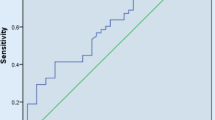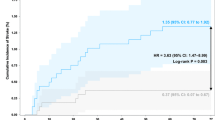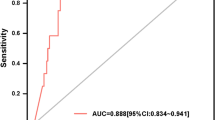Abstract
Atrial fibrillation (AF) is common following ST-segment elevation myocardial infarction (STEMI). Increased blood levels of mid regional pro atrial natriuretic peptide (MR-proANP) have been associated with a greater risk of incident AF. However, knowledge of the value of MR-proANP in predicting incident AF after STEMI is sparse. To assess whether MR-proANP measured at admission is associated with development of incident AF in patients with STEMI. 673 STEMI patients with no history of AF treated with primary percutaneous coronary intervention (pPCI) were prospectively enrolled from September 2006 to December 2008. Blood samples were drawn before the procedure. MR-proANP was measured by an automated processing assay. End point was incident AF. Median follow-up time was 5.5 years (interquartile-range 4.7–6.0), during which 63 patients developed AF. In a multivariable Cox regression model adjusted for relevant clinical and biochemical variables, MR-proANP was significantly associated with the development of AF (HR 1.18 per 100 pmol, 95% CI 1.11–1.28, p < 0.001). In a subgroup of patients who underwent echocardiography (N = 360), MR-proANP remained significantly associated with the development of AF (HR 1.39 per 100 pmol, 95% CI 1.13–1.71, p = 0.002) after adjusting for clinical and biochemical variables and left ventricular ejection fraction. When stratifying patients according to tertiles of MR-proANP, patients in the upper tertile displayed an 11 times greater risk of developing AF during follow-up as compared to patients in the lower tertile (HR 11.1, 95% CI 4.4–28.2, p < 0.001). Plasma MR-proANP measured at admission is an independent predictor of incident AF after STEMI.


Similar content being viewed by others
References
Schmitt J, Duray G, Gersh BJ, Hohnloser SH (2009) Atrial fibrillation in acute myocardial infarction: A systematic review of the incidence, clinical features and prognostic implications. Eur Heart J 30:1038–1045
Jons C, Thomsen PEB (2012) Treating cardiac arrhythmias detected with an implantable cardiac monitor in patients after an acute myocardial infarction. Curr Treat Options Cardiovasc Med 14:39–49
Levin E, Gardner D, Samson W (1998) Natriuretic Peptides. N Engl J Med 339:321–328
George J, Struthers AD (2007) Chapter 31 - Natriuretic Peptides. In: Lip GYH, Hall JE (eds) Comprehensive Hypertension. Mosby; Philadelphia, pp 349–362
Morgenthaler NG, Struck J, Thomas B, Bergmann A (2004) Immunoluminometric assay for the midregion of pro-atrial natriuretic peptide in human plasma. Clin Chem 50:234–236
Berntsson J, Smith JG, Nilsson PM (2017) Pro-atrial natriuretic peptide and prediction of atrial fibrillation and ¨ Preventive Project stroke: The Malmo Preventive Project. Eur J prev Cardiol 24:788–795
Shiroto H, Tomita H, Hagii J, Metoki N, Fujita A, Kamada T, Takahashi K, Saito S, Sasaki S, Hitomi H, Seino S, Baba Y, Uchizawa T, Iwata M, Matsumoto S, Yasujima M, Okumura K (2017) Impact of atrial natriuretic peptide value for predicting paroxysmal atrial fibrillation in ischemic stroke patients. J Stroke Cerebrovasc Dis 26:772–778
Chen LY, Chong JP, Chang IC, Austin E, Quay CN, Richards AM, Ling LH (2013) Plasma mid-regional pro-atrial natriuretic peptide is associated with and improves prediction of lone atrial fibrillation. Eur Heart J 34:P4065–P4065
Karolina I, Michał K, Marzenna Z (2020) MR-proANP level predicts new onset atrial fibrillation in patients with acute myocardial infarction. Biomarkers 25:573–577
Lindberg S, Jensen JS, Hoffmann S, Iversen AZ, Pedersen SH, Biering-Sørensen T, Galatius S, Flyvbjerg A, Mogelvang R, Magnusson NE (2016) Plasma neutrophil gelatinase-associated lipocalin reflects both inflammation and kidney function in patients with myocardial infarction. CardioRenal Med 6:180–190
Hunter I, Alehagen U, Dahlström U, Rehfeld JF, Crimmins DL, Goetze JP (2011) N-terminal pro-atrial natriuretic peptide measurement in plasma suggests covalent modification. Clin Chem 57:1327–1330
Levey AS, Bosch JP, Lewis JB, Greene T (1962) Annals of internal medicine. Philadelphia JAMA 182:217
Schmidt M, Schmidt SAJ, Sandegaard JL, Ehrenstein V, Pedersen L, Sørensen HT (2015) The Danish National patient registry: a review of content, data quality, and research potential. Clin Epidemiol 7:449–490
Helweg-Larsen K (2011) The Danish register of causes of death. Scand J Public Health 39:26–29
Sundbøll J, Adelborg K, Munch T, Frøslev T, Sørensen HT, Bøtker HE, Schmidt M (2016) Positive predictive value of cardiovascular diagnoses in the Danish National Patient Registry: a validation study. BMJ Open 6:e012832
Vittinghoff E, McCulloch CE (2007) Relaxing the rule of ten events per variable in logistic and cox regression. Am J Epidemiol 165:710–718
Smith JG, Newton-Cheh C, Almgren P, Struck J, Morgenthaler NG, Bergmann A, Platonov PG, Hedblad B, Engstrm G, Wang TJ, Melander O (2010) Assessment of conventional cardiovascular risk factors and multiple biomarkers for the prediction of incident heart failure and atrial fibrillation. J Am Coll Cardiol 56:1712–1719
Wang TJ, Larson MG, Levy D, Benjamin EJ, Leip EP, Omland T, Wolf PA, Vasan RS (2004) Plasma natriuretic peptide levels and the risk of cardiovascular events and death. N Engl J Med 350:655–663
Tsang TSM, Barnes ME, Bailey KR, Leibson CL, Montgomery SC, Takemoto Y, Diamond PM, Marra MA, Gersh BJ, Wiebers DO, Petty GW, Seward JB (2001) Left atrial volume: Important risk marker of incident atrial fibrillation in 1655 older men and women. Mayo Clin Proc 76:467–475
Parashar S, Kella D, Reid KJ, Spertus JA, Tang F, Langberg J, Vaccarino V, Kontos MC, Lopes RD, Lloyd MS (2013) New-onset atrial fibrillation after acute myocardial infarction and its relation to admission biomarkers (from the TRIUMPH Registry). Am J Cardiol 112:1390–1395
Sinner MF, Stepas KA, Moser CB, Krijthe BP, Aspelund T, Sotoodehnia N, Fontes JD, Janssens ACJW, Kronmal RA, Magnani JW, Witteman JC, Chamberlain AM, Lubitz SA, Schnabel RB, Vasan RS, Wang TJ, Agarwal SK, McManus DD, Franco OH et al (2014) B-type natriuretic peptide and C-reactive protein in the prediction of atrial fibrillation risk: The CHARGE-AF Consortium of community-based cohort studies. Europace 16:1426–1433
Schnabel RB, Larson MG, Yamamoto JF, Sullivan LM, Pencina MJ, Meigs JB, Tofler GH, Selhub J, Jacques PF, Wolf PA, Magnani JW, Ellinor PT, Wang TJ, Levy D, Vasan RS, Benjamin EJ (2010) Relations of biomarkers of distinct pathophysiological pathways and atrial fibrillation incidence in the community. Circulation 121:200–207
Parlak E, Adiyaman A, Berg J, Van ’T Hof AWJ, Elvan A, (2013) NTproBNP and clinical predictors of incident atrial fibrillation in ST elevation myocardial infarction patients undergoing primary percutaneous coronary intervention. Eur Heart J 34:P5621
Baba M, Yoshida K, Ieda M (2019) Clinical applications of natriuretic peptides in heart failure and atrial fibrillation. Int J Mol Sci 20:2824
St. John Sutton MG, Sharpe N (2000) Left ventricular remodeling after myocardial infarction: Pathophysiology and therapy. Circulation 101:2981–2988
Tsang TSM, Gersh BJ, Appleton CP, Tajik AJ, Barnes ME, Bailey KR, Oh JK, Leibson C, Montgomery SC, Seward JB (2002) Left ventricular diastolic dysfunction as a predictor of the first diagnosed nonvalvular atrial fibrillation in 840 elderly men and women. J Am Coll Cardiol 40:1636–1644
Casaclang-Verzosa G, Gersh BJ, Tsang TSM (2008) Structural and functional remodeling of the left atrium. clinical and therapeutic implications for atrial fibrillation. J Am Coll Cardiol 51:1–11
De Jong AM, Maass AH, Oberdorf-Maass SU, Van Veldhuisen DJ, Van Gilst WH, Van Gelder IC (2011) Mechanisms of atrial structural changes caused by stretch occurring before and during early atrial fibrillation. Cardiovasc Res 89:754–765
Page RL, Wilkinson WE, Clair WK, McCarthy EA, Pritchett ELC (1994) Asymptomatic arrhythmias in patients with symptomatic paroxysmal atrial fibrillation and paroxysmal supraventricular tachycardia. Circulation 89:224–227
García-Fernández A, Roldán V, Marín F (2017) Strategies for prediction and early detection of atrial fibrillation: Present and future. Europace 19:515–517
Acknowledgements
N/A
Author information
Authors and Affiliations
Corresponding author
Ethics declarations
Conflict of interest
N/A.
Additional information
Publisher's Note
Springer Nature remains neutral with regard to jurisdictional claims in published maps and institutional affiliations.
Supplementary Information
Below is the link to the electronic supplementary material.
Rights and permissions
About this article
Cite this article
Wegener, A., Modin, D., Pedersen, S. et al. MR-proANP measured at admission is associated with incident atrial fibrillation in STEMI patients. Heart Vessels 37, 1906–1913 (2022). https://doi.org/10.1007/s00380-022-02099-8
Received:
Accepted:
Published:
Issue Date:
DOI: https://doi.org/10.1007/s00380-022-02099-8




